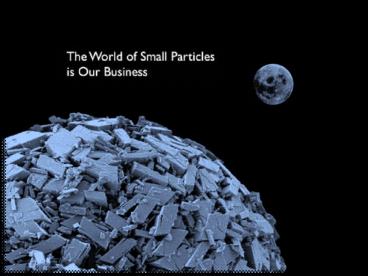Dias nummer 1 - PowerPoint PPT Presentation
1 / 26
Title:
Dias nummer 1
Description:
Particle Analytical is the leading contract laboratory in Europe. A complete state-of-the-art ... Concentration, sonication, surfactant concentration etc. ... – PowerPoint PPT presentation
Number of Views:94
Avg rating:3.0/5.0
Title: Dias nummer 1
1
(No Transcript)
2
Science with a little more bite!
3
About us Particle Analytical is the leading
contract laboratory in Europe. A complete
state-of-the-art laboratory that offers you a
broad range of particle characterisation
techniques.
4
About us We focus on the pharmaceutical
industry, RD, production and quality control.
We are GMP certified by the Danish Medicines
Agency We have been inspected by the FDA
5
Particle characterisation Typical method
development for laser diffraction
includes Finding suitable dispersion
medium Concentration, sonication, surfactant
concentration etc. Correlation to independent
technique (SEM and/or microscopy) Repeatability
test Intermediate precision
6
How to set optical parameters for laser
diffraction measurements
7
For laser diffraction two theories Fraunhofer Mie
8
Laser diffraction Data and fit
Scattering pattern
9
Effect of optical model
Red Fraunhofer Green Mie using assumed values
for RI and Absorption Blue Mie using determined
values for RI and Absorption
10
Typical approach for Mie is to ASSUME values of
Refractive index Absorbtion index
11
Refractive index Refractive index often assumed
to be 1.3 to 2.1 for organics. Most often Default
value is used with no justification
12
Can you actually influence your result by
choosing these values and is it safe to operate
in the ASSUMED levels?
13
Small changes ? large variationsDo not assume
your values!
14
There should not be a signal below 1 µm
15
Wide agreement on Mie is the most correct optical
model for laser diffraction Do you know the
optical parameters of your product or do you
assume? Are your results correct? In pharma not
ok to ASSUME! Needs justification
16
Refractive index Methods for determining
refractive index
Becke lines Schroeder van der Kolk Saveyn Calculat
ion ChemSketch Refractive index matching
oils Fit Concentration Lowest residual
Not as easy as it seems. Most methods only works
in few cases.
17
Becke lines Becke lines is typically first choice
Becke line does not always work Time consuming
18
The other techniques for determining RI have
proven unreliable for many pharmaceutical compunds
19
Lowest weighted residual normally not
posssible Often stated that you can determine
absorption and RI by finding the minimum for
weighted residual.
No minimum is reached
20
Absorption Absorption is often assumed to
be 0.001 for Emulsions 0.01 for white powder 0.1
for slightly coloured particles 1 or above for
heavily coloured Most often default values are
used without justification.
21
Absorption
No (or very few) suggested methods in literature
for determining the absorption. Recomendations
for values based on color of the particles. It
is recommended to determine the absorption value
by minimising the weighted residual . This
requires that you find the minimum weighted
residual. This requires a lot of calculations to
be performed.
22
Absorption
23
Absorption
24
Impact on the result
25
Summary The choice of optical model affects your
result Mie parameters must be justified NOT
assumed Change of Mie parameters will change your
result Traditional method development for laser
diffraction is critical
26
(No Transcript)































